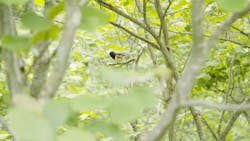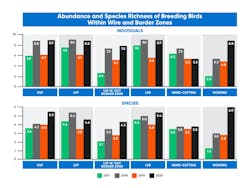Over the past three years, the State Game Lands 33 (SGL 33) research project in central Pennsylvania has added to decades of environmental studies concerning the impact of vegetation management strategies on natural resources throughout utility rights-of-way (ROW), including various plant communities and wildlife groups.
In addition to ground beetles, snakes and bee species, this research most recently focused on breeding bird populations and their responses to different vegetation management strategies. In recent years, breeding bird populations have declined significantly throughout the United States due to evolving land use practices and the suppression of natural disturbances that create early successional habitat for native bird communities. That’s why SGL 33 researchers are committed to enhancing awareness of the benefits a wire zone-border zone method can provide to Integrated Vegetation Management (IVM) programs.
Since being first tested in the early 1980s, the wire zone-border zone method of IVM has benefited early successional bird species on a number of plots throughout SGL 33. This notion was further supported by a report recently provided by SGL 33 researchers with Pennsylvania State University (PSU) to industry cooperators. The report detailed a number of key findings concerning breeding bird populations and their response to five different vegetation control methods commonly used to manage incompatible plant species throughout utility ROW. In addition to mechanical mowing and hand-cutting, the following herbicide treatments were applied to SGL 33 plots in 2016:
· High-volume foliar (nonselective)
· Low-volume foliar (selective)
· Low-volume basal bark
The size of each test plot was approximately 3 acres at SGL 33, and each strategy tested was managed to include a 95-foot wire zone and 30-foot border zone on each side of transmission line corridors. As ideal landscapes for assessing each method of control and associated effects on breeding bird species, these plots yielded valuable data and insights for utility vegetation managers working to enhance electrical transmission reliability as well as environmental sustainability for breeding birds and other wildlife species.
Results from this research generally favored the use of selective herbicide applications for biodiversity management over mechanical treatments or nonselective herbicide applications. Other notable takeaways from the past three years of study include:
· Low-volume foliar and low-volume basal application sites with accompanying border zones contained a higher abundance and richness of breeding birds than mechanically treated sites or sites with no border zone at all.
· The abundance of breeding birds was consistently lower on sites treated with hand-cutting and mowing strategies.
· A higher abundance and richness of breeding birds were noted in areas where selective herbicide treatments were used as part of an IVM-based approach for both wire zone and border zone management.
State Game Lands 33 Research Report to Cooperators: 2018-2021.
In addition to sites managed with herbicides on SGL 33, additional sites at State Game Lands 103 in Centre County, Pennsylvania were either comparable or more beneficial to breeding bird communities in terms of productivity and nesting success than areas to which mechanical treatments were applied. Another noteworthy takeaway is that border zone establishment can be largely responsible for the retention of large and diverse bird populations throughout utility ROW. As indicated by the last three years of results recorded through SGL 33 research, the presence of border zones — even narrow border zones — along the wire zone can be the most important predictor of diverse breeding bird communities.
Using the right strategies can help utility vegetation managers protect not only utility infrastructure and electrical transmission reliability, but also habitat biodiversity. As a funding partner of SGL 33 research, Corteva Agriscience launched HabitatWithHerbicides.com, a digital platform through which the organization regularly shares SGL 33 research updates and success stories regarding the application of IVM practices throughout utility ROW corridors.
For more insights and results from the past three years of SGL 33 research, access the 2021 Floral and Faunal Research Report from PSU. The utility vegetation management page produced by Corteva also provides additional information regarding best practices and recommendations for vegetation managers working to safeguard utility infrastructure and the environment.
™ Trademark of Corteva Agriscience and its affiliated companies.
Sponsored By:


